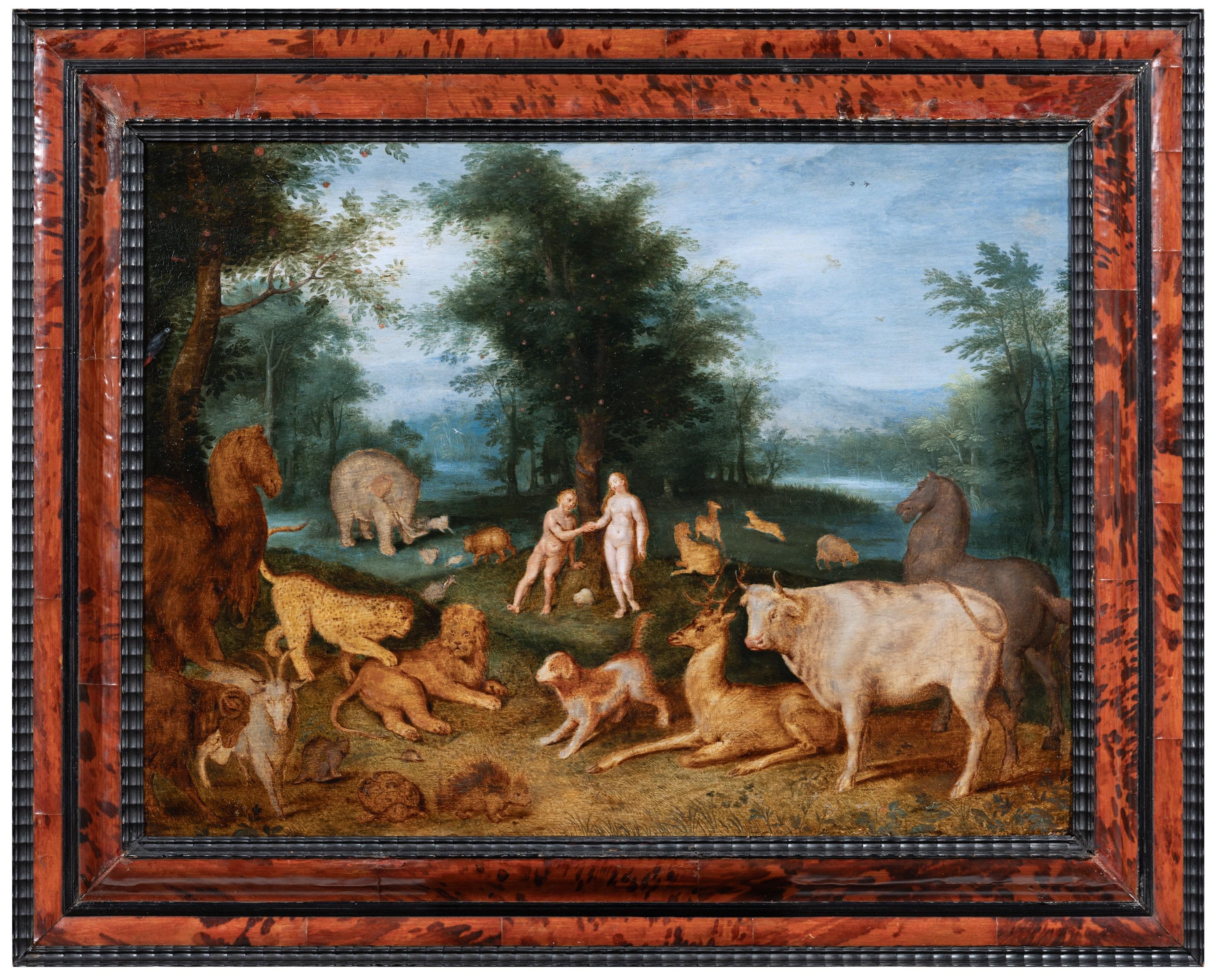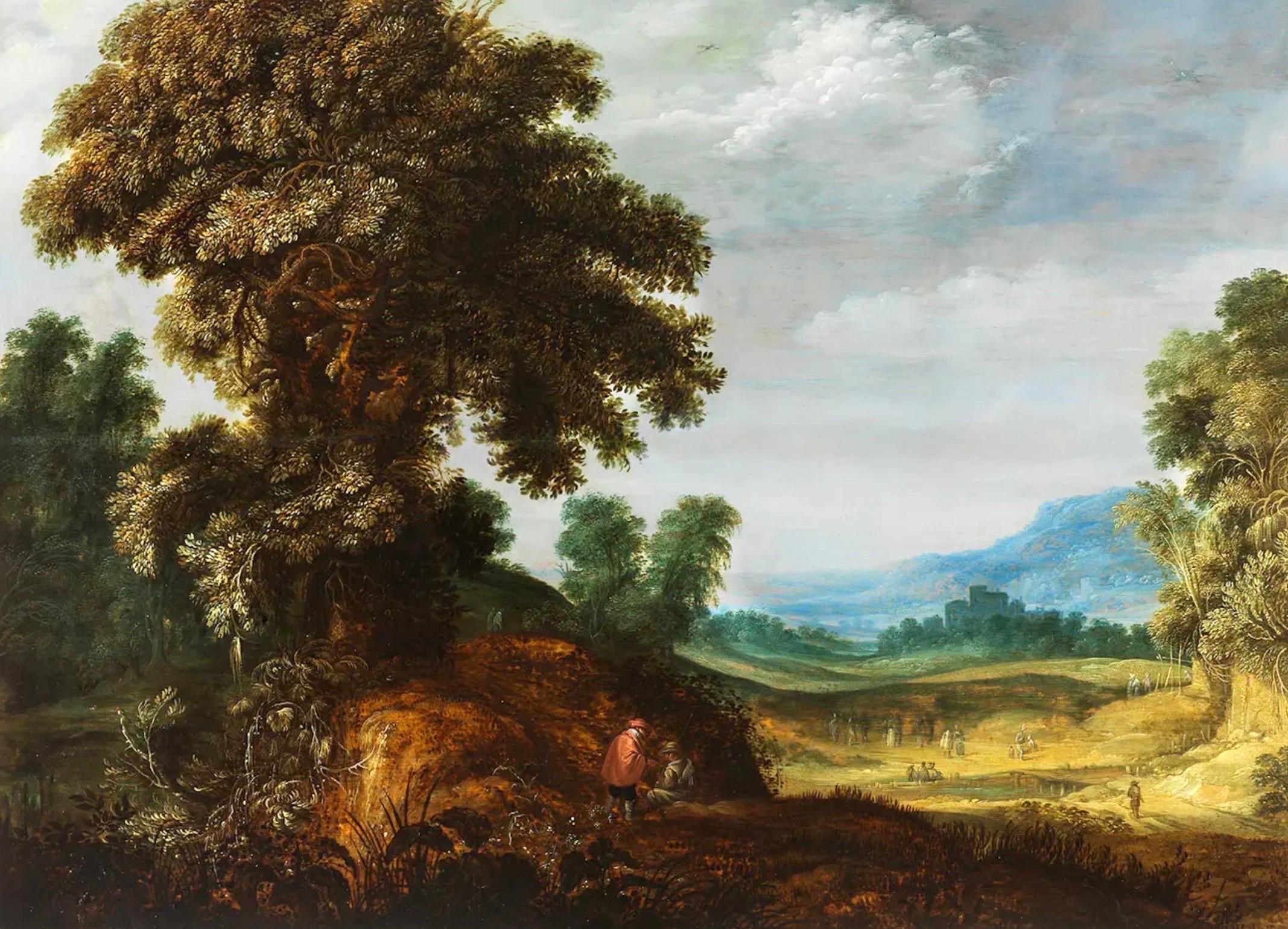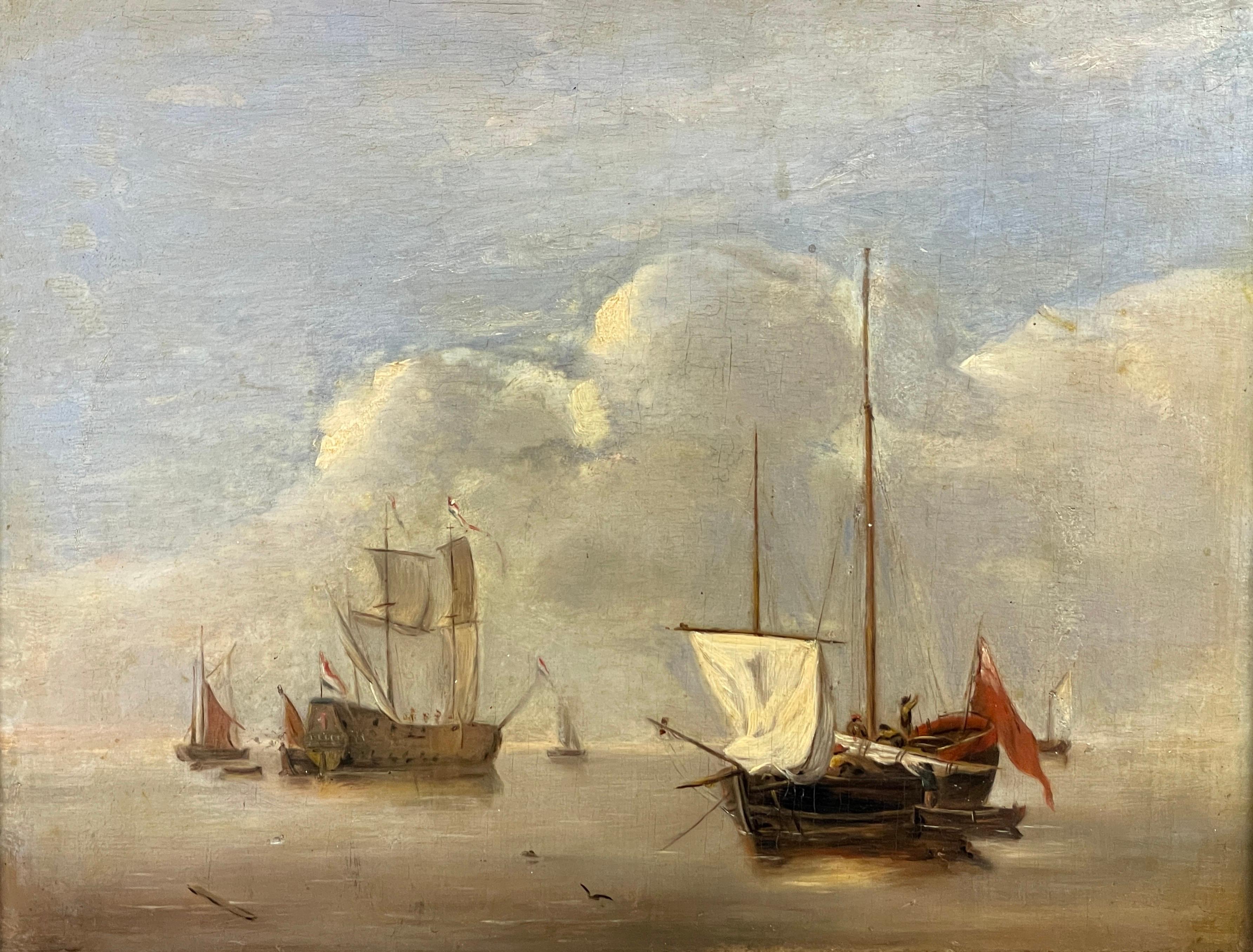Items Similar to A Peasant Removing a Plaster: The Sense of Touch. By a Follower of David Teniers
Video Loading
Want more images or videos?
Request additional images or videos from the seller
1 of 7
A Peasant Removing a Plaster: The Sense of Touch. By a Follower of David Teniers1700 s
1700 s
About the Item
David Teniers the Younger (1610-1690) Follower of
A Peasant Removing a Plaster: The Sense of Touch
signed T on the table
oil on panel
panel size 7,20 x 5,55 inches (18,3 x 14,4 cm)
frame 11,22 x 9,84 inches (28,5 x 25 cm)
oak frame professionally handmade 2021
Provenance:
Old Christie's stamp on the back;
Private collection Poland;
Desa Auction Poland, 6 October 2020, Lot 55.
- Creation Year:1700 s
- Dimensions:Height: 11.23 in (28.5 cm)Width: 9.85 in (25 cm)
- Medium:
- Movement & Style:
- After:David Teniers the Younger (1610 - 1690, Flemish)
- Period:
- Condition:Slightly yellowed varnish. Retouches in the sky and in some small places. Gives an overall good impression. Handmade oak frame from 2021.
- Gallery Location:Stockholm, SE
- Reference Number:1stDibs: LU144528263032
About the Seller
5.0
Platinum Seller
These expertly vetted sellers are 1stDibs' most experienced sellers and are rated highest by our customers.
Established in 2020
1stDibs seller since 2020
118 sales on 1stDibs
Typical response time: <1 hour
Associations
International Confederation of Art and Antique Dealers' Associations
- ShippingRetrieving quote...Ships From: Stockholm, Sweden
- Return PolicyA return for this item may be initiated within 2 days of delivery.
More From This SellerView All
- Italian Landscape With Figures at a Waterfall by a Follower of Jan van HuysumBy Jan Van HuysumLocated in Stockholm, SEThere are so many details to fall in love with in this 18th-century painting depicting an Italianate landscape, for example, the delicately painted figures having a conversation and ...Category
Early 18th Century Old Masters Landscape Paintings
MaterialsWood Panel, Oil
- Landscape with Gentleman on Horseback and Peasant Woman Receiving AlmsBy Philips WouwermanLocated in Stockholm, SEWorkshop / Circle of Philips Wouwerman (1619-1668) Landscape with Gentleman on Horseback and Peasant Woman Receiving Alms oil on oak panel 12.40 x 14.17 inches (31.5 x 36 cm) wit...Category
17th Century Old Masters Landscape Paintings
MaterialsOak, Oil, Wood Panel
- Dutch School, 17th Century, Shipping in a Stiff Breeze, a City BeyondLocated in Stockholm, SEWe are delighted to present a significant piece from the Dutch School, most likely dating back to the late 17th century. This captivating painting showcases the dynamic force of nature with three ships vigorously navigating through stormy waters. The foreground is a scene of nautical struggle, as figures are depicted working intensely with the sails, steering, and bracing against the tumultuous sea. In the serene background, the silhouette of a quaint town emerges, with spires from churches and the outlines of various buildings is visible. This juxtaposition of the calm town against the chaotic foreground serves as a powerful reminder of the unpredictability of life and nature. Dominating the canvas, the sky occupies two-thirds of the painting, filled with brooding clouds that occasionally break to reveal patches of blue. The presence of birds adds a dynamic element to the otherwise ominous atmosphere. While the artist remains unknown, the work is quintessentially Dutch in its execution, with meticulous attention to detail and a profound understanding of maritime life. The painting's oval shape is quite distinctive and is complemented by a suitably antique octagonal black frame, which adds to its historical charm. This piece is a testament to the mastery of Dutch maritime painting...Category
17th Century Old Masters Landscape Paintings
MaterialsOak, Oil, Wood Panel
- Peasants in a Cornfield (Boer in het veld) by David Teniers the YoungerBy David Teniers the YoungerLocated in Stockholm, SERemembering the magic of everyday life moments in the art of David Teniers: The art of David Teniers the Younger (1610–1690) coincided with the heyday of the Flemish Baroque and captured a great variety of motifs of his time. In this painting of a seemingly simple peasant scene lies keys to understanding both the imaginative mind of Teniers as well as why this time period produced some of the most iconic works in all of art history. As indicated by the name, Teniers was more or less born into his profession. As the son of David Teniers the elder, himself a painter who studied under Rubens, the younger David received training in art from a very young age and had no less than three brothers who also became painters. Because of his father’s frequent financial failures that even at times saw him imprisoned, David the younger helped to rescue the family from ruin through painting copies of old masters. Essentially, the young Teniers was confronted with painting as both a passion and creative expression as well as a necessity during difficult times, an experience that would shape much of his capacity and sensitivity in his coming life. Despite the hardships, the talent and determination of Teniers was recognized and quickly expanded his possibilities. He had already spent time in France and possibly also England when he was hired by his father’s former teacher Rubens to help with a prestigious commission with mythological paintings, now considered lost, for Philip IV the king Spain. In 1644–54 Teniers was appointed dean of the Antwerp Guild of Saint Luke, manifesting his esteemed position within the artistic community. A few years afterwards he took an important step when relocating to Brussels, where Teniers yet again found new career opportunities that would prove to be very successful. As the keeper of the collections of Archduke Leopold Wilhelm, a role similar to what we now refer to as an art advisor, Teniers purchased hundreds of important artworks that manifested the prominent status of the Archduke’s collection while at the same time providing an unusual access to inspiration and knowledge for Teniers himself. Since he kept on painting during the same time, his creative scope must have seemed almost bewildering in the great variety of images and stories that he surrounded himself with. Regardless of how glamorous and culturally stimulating the career of Teniers was, he was as open to the charm and existential importance of everyday life as he was to works of great masters and luxurious collectibles. In his impressive repertoire of genres with everything from exquisite royal portraits, interiors, landscapes and history paintings he always added something new and inventive, highlighting the possibilities of art and importance of an experimental and intuitive mind. It is difficult to single out one aspect or genre to summarize his legacy, since it lies much more in the broad virtuosity across many motifs, although he is particularly remembered for farm scenes and meticulously depicted interiors where other paintings and artworks are captured with an astonishing precision. However, the fact that he is still today one of the most known and celebrated names of the Dutch Golden Age is a proof to the magic of his work, which continues to spark dialogue and wonder in the contemporary viewer of his works. The farm boy in the field in this painting, which likely dates to the mature part of his career, is a wonderful entry into the mind of Teniers. In the tightly cropped motif, we see him standing right in the middle of the busy harvest when men, women and everyone capable were sent out in the field to collect the crop that formed the very core of their diet and survival. In the background we see a fresh blue sky interspersed with skillfully painted clouds, some trees reaching their autumnal colours and in the far distance the glimpse of a small church and village. The presence of a church in a landscape, so typical of Dutch art, served both a symbolic and visual function as a representation of faith while at the same time defining scale and distance. In the field, the work is in full action with the farmers spread out in various positions, all in the midst of hard and sweaty labour. While they are portrayed as having nothing else than the work on their mind, our farm boy seems to have his attention directed elsewhere. Standing there with his white, half open shirt, flowy curls and strong, sturdy body; his gaze is directed away, out of the picture and the scythes in his hands. He looks almost smirking, expressed with tremendous subtlety in the slight smile of his lips and big eyes, being just in the middle of losing focus on the work. What is it that steals his attention? What has he seen, or realized, or felt – to break him free of the arduous task of harvesting, if but for a moment? Here starts the wondering and the questions that are the hallmark of a great piece of art. Instead of explicitly locking in the motif in overly clear symbolism Teniers has chosen an open ended, subtle yet striking moment for us to consider. While it of course can be related to numerous other farm scene depictions of this time, and clever usages of gazes and real-life scenes to underscore various moral or symbolic meanings, the painting can be much more of a contemplation than an explanation or illustration. The ordinary nature and understated yet emotionally textured composition of the motif gives greater space for our own reactions and thoughts. Has he seen a pretty farm girl just passing by? Is he fed up with the farm life, joyously dreaming away for a minute, imagining another future? Or is he simply in need of distraction, looking away and ready for anything that can steal his attention? One quality that never seem to have escaped Teniers was that of curiosity. During all of his career he constantly investigated, expanded and experimented with not only the style and technique of painting, but with the vision of art itself. Being credited with more or less introducing farm motifs for a broader audience not only tells us of his ability to understand the demand for different motifs, but the sensitivity to transform seemingly ordinary parts of life into deep aesthetic experiences, far beyond their expected reach. The farm boy in this painting is, of course, exactly that. But with the help of one smirk the entire picture is charged with a different energy, awakening many contrasts and relationships between the calm landscape, the hard work and his own breach of effectivity, holding sharp scythes while thinking or seeing something else. It is no wonder Teniers chose to work with farm scenes as a way of investigating these intricate and delicate plays on expectations and surprises, clarity and ambivalence. It invites us to an appreciation of human everyday life that connects us with the people of 17th century...Category
Late 17th Century Old Masters Landscape Paintings
MaterialsOil, Canvas
- A 17th Century Mythological SceneLocated in Stockholm, SEThis small yet captivating painting, crafted on a copper plate, dates back to the mid-1600s and was created by a Flemish artist. Subject Matter: The central figure in the artwork is Mercury, easily identified by his symbolic attributes like winged sandals, petasus, and caduceus. Beside him is a likely female figure, characterized by her attire and absence of weaponry. The depicted scene could represent two mythological tales: Mercury and Calypso: This interpretation suggests the artwork shows the moment Zeus sends Mercury to Calypso's island, Ogygia. Mercury is there to order Calypso to release Ulysses, whom she saved from a shipwreck but kept captive. The lush, wooded background and the three distant figures could hint at Ulysses' farewell to Calypso. Mercury and Herses: Another interpretation could be a scene from the love story of Mercury and Herses. The background figures might symbolize the sisters returning from a procession, while the forefront could be the initial meeting between Mercury and the most beautiful sister, Erse. Artistic Inspiration: The painting's landscape and setting are heavily influenced by the early 17th century Northern European art trends, especially the works of Jan Brueghel the Elder. However, the artwork stands apart with its unique luminescence in detailing and a distinctive approach to depicting figures. While the exact origin and artist remain somewhat mysterious, the style and treatment of light hint towards works close to Josse de Momper...Category
Mid-17th Century Old Masters Figurative Paintings
MaterialsCopper
- A Wooded Landscape With Riders, Attributed to Pieter Gysels (Peeter Gijsels)Located in Stockholm, SEPieter Gysels, also known as Peeter Gijsels, was a renowned Flemish painter who lived from 1621 to 1690/91. He was known for his landscapes, which often depicted idyllic scenes from nature, and his works are highly sought after by Old Master collectors. We are proud to offer a newly discovered pair of landscapes attributed to him; this one called "A Wooded Landscape With Riders" This stunning painting captures the beauty of a serene summer day in the countryside. In the foreground, we see a couple riding on horsebacks, enjoying the peaceful surroundings. The horses seems to be trotting gently, and the riders are relaxed, taking in the natural splendour around them. In the distance, we see several other figures, perhaps farmers or peasants, doing their daily tasks. We also see a small stream flowing through the landscape, with several small houses. And in the background, we see a beautiful wooded area with tall trees reaching up towards the sky. The attention to detail in this painting is truly remarkable. Gysels use of vibrant colours evoke the warmth and beauty and he skillfully captured the play of light on the landscape, creating a sense of depth and atmosphere. The detailing of the cottages, the colors, the use of big-leafed plants in the foreground, and the figure types are typical of his signature style. "A Wooded Landscape With Riders" is painted on copper, which gives the painting a unique luminosity and depth. The use of copper as a support for paintings was popular in the seventeenth century. We also have one more painting called "Wooded Landscape With an Elegant Company...Category
17th Century Old Masters Landscape Paintings
MaterialsCopper
You May Also Like
- 17th century Flemish Old Master painting - Vast landscape with a fortified townLocated in Antwerp, BE17th century Flemish old master painting depicting a peaceful countryside scenery of a vast landscape with a fortified town visible in the distance by Lucas Van Uden Lucas Van Uden'...Category
17th Century Old Masters Landscape Paintings
MaterialsPanel, Oil
- Adam and Eve in paradise, studio of Jan Brueghel the Younger, 17th centuryLocated in PARIS, FRStudio of Jan Brueghel the Younger 17th century Antwerp school Oil on oak panel, h. 37 cm, w. 49 cm Tortoiseshell veneered baroque style frame...Category
Mid-17th Century Old Masters Figurative Paintings
MaterialsOil, Wood Panel
- 17th century Flemish Old Master painting - Vast landscape with a majestic oakLocated in Antwerp, BE17th century Flemish old master painting depicting a forest landscape with a majestic oak Alexander Keirincx, born around 1600 in Antwerp, Belgium, was a prominent Flemish landscape...Category
17th Century Old Masters Landscape Paintings
MaterialsOil, Panel
- Shipping in Calm Waters, 18th Century Dutch Oil on Wood Panel, Man o WarLocated in Cirencester, GloucestershireShipping in Calm Waters Dutch School, 18th century oil painting on wood panel panel: 10 x 12.75 inches framed: 14 x 17 inches condition: very good, minor evidenc...Category
18th Century Old Masters Landscape Paintings
MaterialsWood Panel, Oil
- Flemish 17th c., Allegory of war and peace, circa 1630, by Adriaen van StalbemtLocated in PARIS, FRAdriaen van Stalbemt (Antwerp, 1580-1662) Allegory of Peace and War, circa 1620-1630 Oil on oak panel: h. 49.5 cm, l. 73.2cm (19.29 x 28.74 in) Giltwood frame with laurel leaves, Lo...Category
Early 17th Century Old Masters Figurative Paintings
MaterialsOil, Panel
- Macbeth and the Three Witches a Painting on Panel by Francesco ZuccarelliBy Francesco ZuccarelliLocated in PARIS, FRThis painting, created during Zuccarelli's stay in England, represents the decisive moment when Macbeth, together with Banquo, meets the three witches who announce that he will be Ki...Category
1760s Old Masters Landscape Paintings
MaterialsOil, Wood Panel





